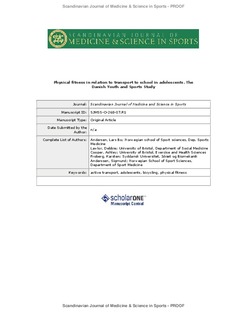| dc.contributor.author | Andersen, Lars Bo | |
| dc.contributor.author | Lawlor, Debbie A. | |
| dc.contributor.author | Cooper, Ashley R. | |
| dc.contributor.author | Froberg, Karsten | |
| dc.contributor.author | Anderssen, Sigmund A. | |
| dc.date.accessioned | 2009-06-08T11:43:04Z | |
| dc.date.issued | 2008-05-19 | |
| dc.identifier | Seksjon for idrettsmedisinske fag / Department of Sports Medicine | |
| dc.identifier.citation | Scandinavian Journal of Medicine & Science in Sports. 2009, 19(3), 406-411 | en |
| dc.identifier.issn | 0905-7188 | |
| dc.identifier.uri | http://hdl.handle.net/11250/170565 | |
| dc.description | I Brage finner du siste tekst-versjon av artikkelen, og den kan inneholde ubetydelige forskjeller fra forlagets pdf-versjon. Forlagets pdf-versjon finner du på www.wiley.com: http://www3.interscience.wiley.com/journal/120122907/abstract / In Brage you'll find the final text version of the article, and it may contain insignificant differences from the journal's pdf version. The definitive version is available at www.wiley.com: http://www3.interscience.wiley.com/journal/120122907/abstract | en |
| dc.description.abstract | In many Western countries, there are concerns about declining levels of physical activity in school-aged children. Active transport is one way to increase physical activity in children, but few studies have evaluated whether active transport in school-aged children and adolescents has beneficial effects on fitness and, if so, whether different modes of transport affect different aspects of fitness. In this study, we examined the association of active transport with different aspects of fitness in a representative Danish sample of 545 boys and 704 girls, 15–19 years of age. Physical fitness was assessed through a number of field tests, including a maximal cycle test, dynamic and static strength in different muscle groups, muscle endurance, flexibility and agility. Transport to school was reported as the mode of transport. Almost two-thirds of the population cycled to school. Cyclists had higher aerobic power than both walkers and passive travelers (4.6–5.9%). Isometric muscle endurance (10–16%), dynamic muscle endurance in the abdominal muscles (10%) and flexibility (6%) were also higher in cyclists compared with walkers and passive travelers. Mode of travel was not related to leisure-time sports participation. Our findings suggest that commuter bicycling may be a way to improve health in adolescents. | en |
| dc.format.extent | 289361 bytes | |
| dc.format.mimetype | application/pdf | |
| dc.language.iso | eng | en |
| dc.publisher | Wiley InterScience | en |
| dc.subject | active transport | en |
| dc.subject | adolescent | en |
| dc.subject | bicycling | en |
| dc.subject | physical fitness | en |
| dc.title | Physical fitness in relation to transport to school in adolescents: the Danish youth and sports study | en |
| dc.type | Peer reviewed | en |
| dc.type | Journal article | en |
| dc.subject.nsi | VDP::Social science: 200::Social science in sports: 330 | en |
| dc.source.pagenumber | 406-411 | en |
| dc.source.volume | 19 | en |
| dc.source.journal | Scandinavian Journal of Medicine & Science in Sports | en |
| dc.source.issue | 3 | en |
